Read Reviews
The Best Hedgehog Houses
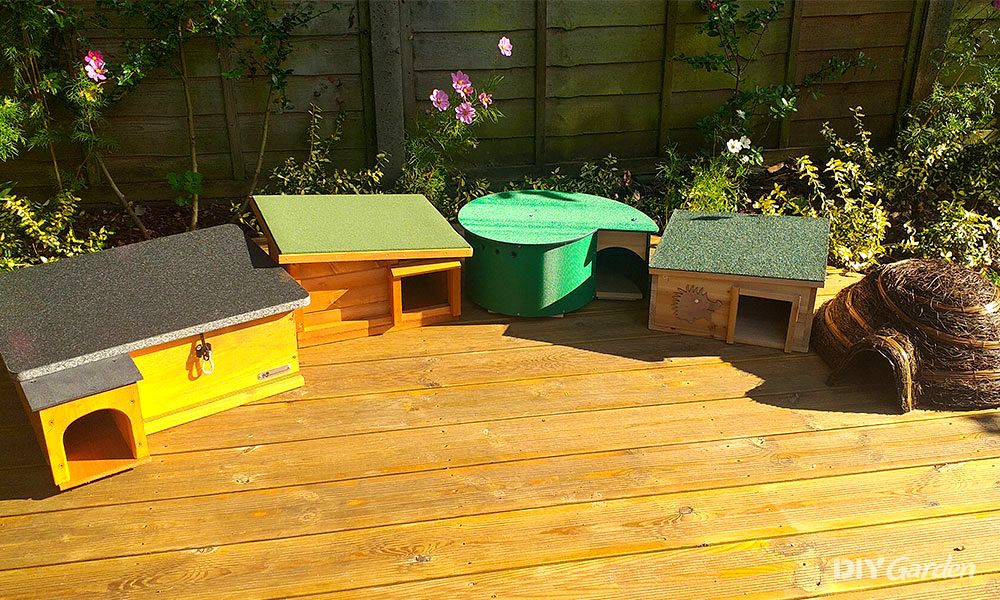
-
Best hedgehog house overall - Riverside Woodcraft Hedgehog House
-
Best designed hedgehog house - Wildlife World Hogilow Hedgehog Home
-
Best value hedgehog house - The Hutch Company Hedgehog House
-
Best flat packed option - Clifford James Hedgehog House
-
Best as a feeding station - Igloo Hedgehog House
Hedgehog House Reviews
1. Riverside Woodcraft Hedgehog House
Best hedgehog house overall
- Large size offers plenty of room for a mother and her hoglets to nest
- Lock keeps the lid firmly in place even if the hedgehog house were to be tipped over
- Quality build and finish; made with solid wood that creates a very robust structure
- Long 'baffle' entryway keeps predators from being able to access the main nesting area
- Easy to clean as the lid hinges completely off and it's easy to reach all of the corners
- May be too large for very small gardens as it could take up too much space
- Shape
- Rectangular
- Weight
- 5kg
- Material
- Wood, composite roof
- Dimensions
- 52cm x 51cm x 20cm
- Assembly?
- No
- Design
- 4.5
- Build Quality
- 5
- Hedgehog Safety
- 5
- Ease of Cleaning
- 5
Riverside Woodcraft’s Hedgehog House is a large hedgehog shelter that feels very durable. It’s much larger than others on the market and I was hopeful it would tick the right boxes – let’s see how it performed.
This hedgehog house has a traditional rectangular shape with a recycled composite roof. I could tell straight away (by trying to shift it from my doorstep!) that it’s a good quality piece. It’s very heavy!
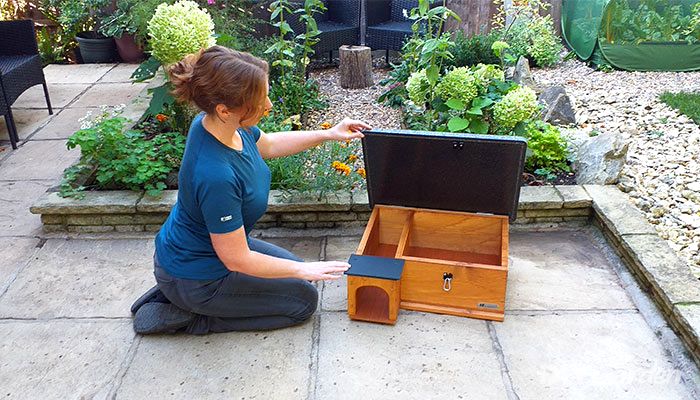
It has a long entry corridor, known as a ‘baffle entrance’ to deter predators and stop them from being able to get into the main room of the house. There’s also a hedgehog-size porch area with a separate plastic-covered roof to keep out rain.
The base has raised feet to keep it off the ground, and there’s a lock to keep the roof in place. I like this locking feature because more determined predators can try to turn over hedgehog houses. This lock kept the roof firmly on, even when I tipped it over. It‘ll also work to keep inquisitive kids out too.
In terms of aesthetics, the house is a lovely rich golden-brown colour that blends into the garden nicely. The makers say it is anti-fungal and anti-bacterial – there no way to test, but it certainly can’t hurt.
Overall, this hedgehog house has a great design – large, roomy and safe. If you’re using it as a feeding station rather than a nesting box, you’ll appreciate the room it provides for two bowls as well.
It loses just half a point for being heavy and therefore a little difficult to move.
This has the best build quality of all the houses I tested.
It’s very well constructed and the parts are of excellent quality. I can tell this house is going to be rainproof and last a long time.
The only down side is that if you have a small garden this house will take up a chunk of space. It’s pretty big.
I’ve already mentioned the fact that this hedgehog house is heavy and therefore difficult for predators to tip. Plus, I also touched on the lock that firmly keeps the lid on, so I won’t labour these points.
There are several other safety features built in to the design as well. The long baffle keeps predator’s paws away from the hedgehogs, and there are excellent ventilation points to keep air flowing through the space.
Additionally, it has great quality flooring and walls, and there are no sharp corners or hard-to-clean pockets that might trap bacteria.
Due to its sturdy construction, it’s also trimmer proof, which offers peace of mind if you were to come into contact with it accidentally. There’s plenty of protection for our spiky friends here.
The lid is hinged and folds all the way back so cleaning is a simple affair.
As mentioned, there are no hard-to-reach areas that will harbour mould or bacteria, and it’s easy to access all parts of the house with a cloth or brush.
Seeing as it’s so straight forward, there isn’t really much else to add!
This is a solid, well-made, traditional house, and it comes out as the best hedgehog house overall.
If you like quality wooden objects, you’ll appreciate the effort that’s gone into this build.
It’s well designed, easy to clean, and has plenty of features that have been well considered to keep little hedgies safe.
I think this hedgehog house will outlast all the others I tested, including the spiral-shaped Wildlife World Hogilow.
The only real downside, if I had to find one, would be its weight and size. It’s not the easiest to move around, and it may be just a bit too big for smaller gardens.
Did you find this review helpful?
2. Wildlife World Hogilow Hedgehog Home
Best designed hedgehog house
- Curved design is an excellent deterrent for predators and makes it impossible for them to get a leg or paw round
- A good medium sized hedgehog house that can be hidden away under a bush
- Uses sustainably-sourced materials with FSC certified timber and recycled agricultural rubber
- Lid stays on firmly even if the house is tipped over
- Several air vents to allow for ventilation and air circulation and limit damp
- Green colour does not blend in very well with the garden
- Shape
- Spiral
- Weight
- 3.85kg
- Material
- FSC certified wood
- Dimensions
- 50cm x 39cm x 23cm
- Assembly?
- No
- Design
- 5
- Build Quality
- 4.5
- Hedgehog Safety
- 5
- Ease of Cleaning
- 4.5
The Wildlife World Hogilow is a popular hedgehog house due to its unusual design, and its infamy was boosted by being featured on Autumn Watch too.
Let’s see if it lives up to the hype.
Straight from the box I could see that this bright-green hedgehog house offered something a little different. It looks good quality and it’s heavy enough to indicate that the materials are solid.
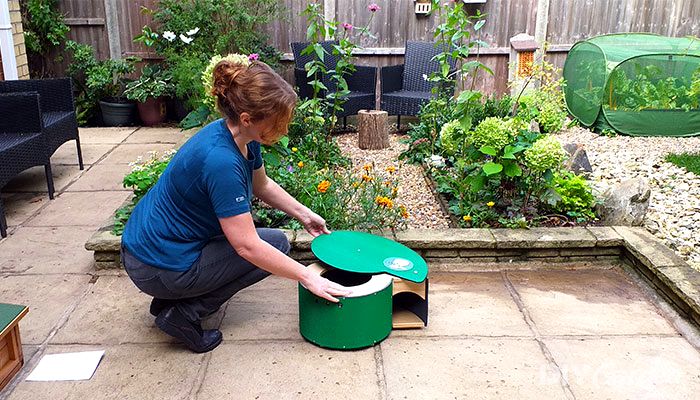
The house measures 50 x 39 x 23 cm, so it can quite easily slip under a bush and be left undisturbed. The lid slides off to one side when access is required and it’s firmly attached. I can see that it won’t flip or blow open in the wind.
The Hogilow is made from FSC certified timber and covered in recycled agricultural rubber. This use of responsibly resourced materials gains a big thumbs up from me; there’s no point trying to save one type of wildlife at the expense of another. I’m pleased to see its green credentials.
Speaking of green – one thing I’m not too keen on is the bright green shade. It stands out in the garden rather than blending in as traditional wooden houses do.
The lid and sides are covered in recycled plastic which is firmly attached. The insides are made from plywood which isn’t particularly sturdy, but the internals don’t really need to be (as long as there are enough other strong features in place) so I won’t hold that against the build quality.
To prevent condensation, there are several vents to allow air in and hedgehog body heat out. This might seem daft, but hedgehog boxes with no ventilation build up condensation from and that can cause the bedding to rot.
The house is a good size for a hedgehog with a litter of babies and it has raised feet to stop the bottom from rotting.
Overall, I really like the build quality; the smooth wood, robust design, and recycled plastic sides result in a top-quality build.
All hedgehog houses need a separate entryway and nesting area to keep them safe from predators.
These long entryways are called a ‘baffle’, and the baffle in this curved-design house is excellent. Thanks to the spiral shape t’s going to be very hard, if not impossible, for a dog, cat, fox, or badger to bend a paw around. The curved design will also help keep out drafts.
The box is heavy enough to stay in place but if it were somehow knocked over the design is secure enough to keep any hedgehogs safely inside.
There are no corners for ticks, dust, or bacteria to get stuck in, and no sharp edges to cause any health risks.
Hedgehog safety has clearly been a top priority for the makers of this hedgehog house.
The easy access roof is simple to open, and leaves enough space to get a hand in for cleaning.
You can’t turn it upside down and shake it as bedding gets trapped on the internals, but it’s simple enough to get your hand inside and pull out the old bedding.
I’ve had a lot of hedgehog houses over the years, and this Wildlife World Hogilow tops most of them. I think it’s one of the best hedgehog houses available on the market.
It’s a well-made house, and the quirky, curved design is effective at keeping hedgehogs safe. Its shape is great for protecting hedgehogs from predators, and I see no reason why hedgehogs wouldn’t set up camp inside.
Whilst there aren’t a lot of downsides, I’m not too keen on the bright green shade and perhaps the plywood internal walls could be made of something stronger. But really there are a lot of benefits that outweigh these two small points.
Did you find this review helpful?
3. The Hutch Company Hedgehog House
Best value hedgehog house
- Good choice for a small garden thanks to its more compact size
- Strong wall between the entryway and living area works as good protection against predators
- Lid locks and remains closed even if the house is tipped over
- Weighing 4.5 kg the house should be quite difficult for predators to tip
- Lid can be completely removed to help with cleaning
- Living area may be on the small side for a mother hedgehog and a litter of hoglets
- The way in which the roof felting has been finished off may lead to water getting into the roof
- Shape
- Rectangular
- Weight
- 4.5kg
- Material
- Timber
- Dimensions
- 46cm x 41cm x 28cm
- Assembly?
- No
- Design
- 4
- Build Quality
- 4.5
- Hedgehog Safety
- 5
- Ease of Cleaning
- 5
The Hutch Company Hedgehog House is a small rectangular wooden hedgehog house with a built-in safety baffle. My first impressions were that it looks well-made and would suit a small garden.
I will admit that I initially stared stupidly at this box for far too long, believing that it didn’t have an entrance. Turns out the door is actually on the longer side, as opposed to the shorter one which would be more conventional.
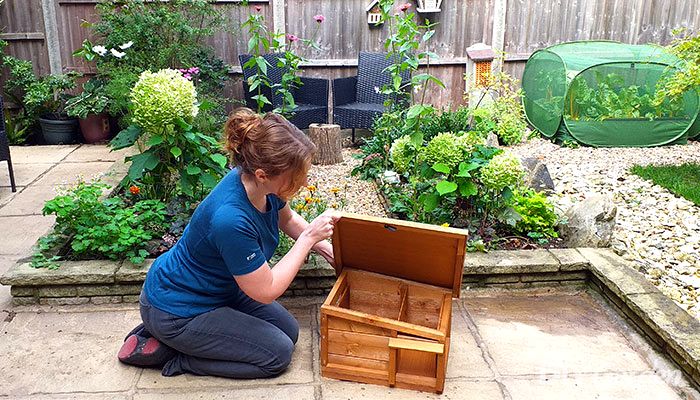
It has a removable roof which is locked down with two twist clips and the corridor is sturdy and acts as a good ‘baffle’ against predators. It separates the entrance from the sleeping area.
On the downside, I think it’s a bit small. It measures 46 x 41 x 28 cm, but nearly half that width is taken up with the baffle partition and entranceway. For this reason I feel it would better suit a hibernating hedgehog than a female with a litter.
Despite the squeeze, the house looks smart and good quality. Its smaller size will definitely be beneficial in small outside spaces.
Overall, the house is sturdy and, for the price, very well made. It’s worth mentioning that this is a cheaper option than the other wood houses featured here.
This hedgehog house looks and feels to be of very good quality. It has a pitched, felt-covered roof and there’s good ventilation in the sleeping area to stop condensation forming.
Two feet on the base keep it elevated off the ground, there’s even a small, porch area with a protruding roof to keep out the rain.
One small thing though: I would prefer to see the waterproof felt tucked over the roof edges. As it is, it seems like the rain could get in and rot the roof. Placing it somewhere dry and reasonably protected will likely help it last longer.
The baffle is strong, I gave it few bashes and the internal wall didn’t look like it would be getting knocked down anytime soon. The lid is also lockable, so in the event of a predator flipping the house, they still won’t be able to access the inside. It weighs a hefty 4.5 kilograms so would be difficult to knock over and is the second-heaviest house I reviewed, second only to the large Riverside home.
Once a hedgehog is inside this house it will be well protected against predators and the elements.
The lid comes completely off so it’s easy to clean the interior with a scrubbing brush or gentle pressure washer. No complaints here.
Emptying the bedding each year won’t be a chore. You can just tip all of it out into a bin liner.
This is one of the best hedgehog houses for small gardens due to its compact size. It’s sturdy, well made, and waterproof. On the downside, I think the ‘living room’ section might be a bit small, especially for a mum and a litter of hedgehogs, and is better suited to a single hibernating hedgehog.
Did you find this review helpful?
4. Clifford James Hedgehog House
Best flat packed option
- Easy to assemble with pre-drilled holes accurately positioned
- A good choice for small gardens because of its compact size
- Constructed from strong, good quality wood
- Easy to clean as the lid can be completely removed
- Very small nesting area is likely only suitable for a hedgehog to hibernate in - not for a litter of hoglets
- There is nothing holding the lid in place so it could come off if a predator tips the house
- Cost does not reflect the extra effort required with the self assembly
- No ventilation holes so you may want to drill some in yourself
- During assembly you may need to scrape off some wood around the pre-drilled holes to properly reveal them
- Shape
- Rectangular
- Weight
- 4.08kg
- Material
- Wood, composite roof
- Dimensions
- 40cm x 40cm x 19cm
- Assembly?
- Yes
- Design
- 3
- Build Quality
- 3
- Hedgehog Safety
- 4
- Ease of Cleaning
- 5
The Clifford James Hedgehog House arrives flat packed. As a result, it’s slightly cheaper than the other wooden models I tested, so let’s see how it performed overall.
This is a square, cedar-wood hedgehog house with a built-in predator baffle and a hedgehog-size entrance way.
The roof is pitched, so rain runs off the waterproof roofing felt, and it has been finished with a water-based varnish (hedgehog safe) to prevent rot – so far so good!
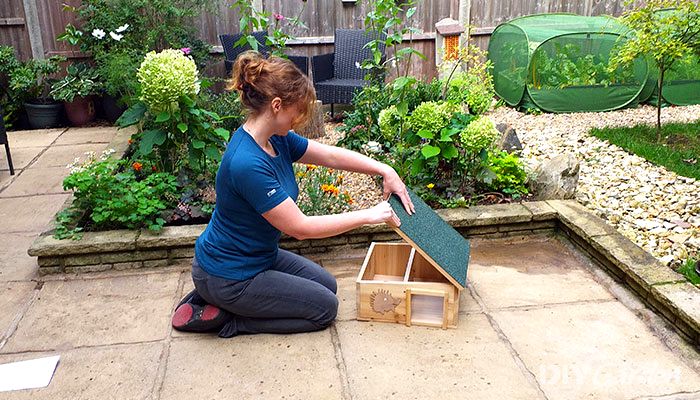
Firstly, I think it could do with some felt over the edges of the roof to keep rain out completely.
Then comes the size: this is the smallest of the hedgehog homes that I tested and I’d say it’s a bit too small overall. At 40 x 40 x 19 cm, there’s could be enough space inside, but half it is taken up by the entrance way. As a result, there’s not a lot of space in the living area for a full-sized hedgehog plus a litter of babies.
It’s also a bit small for two food bowls, if you were planning to use it as a feeding box
There’s no ventilation, so the sleeping area is in danger of becoming slimy and wet which is no good for keeping hedgehogs healthy. If you buy this, I’d recommend drilling a few small holes to let some air in.
There’s a cute hedgehog cut-out on the front, which is a nice idea, but its white painted eye has somehow wound up totally mis-positioned in the middle of its body… I know it’s just a little detail, but it makes me think quality control could have been better.
All the wooden pieces are thick and sturdy, and it has raised feet to keep the base out of mud and rain. It’s strong, and would easily withstand an accidental strike with a strimmer if it came to it.
I can’t fault the quality of wood and the screws are good too. Often, flat-pack screws are weedy little things, or they come with a useless allen key, so I was pleased that these were of a higher standard.
When it comes to assembly, the pieces are numbered and (despite my initial concern) the construction process is fairly simple. In fact, I asked my 10-year-old expert Lego builder to piece it together and he managed just fine.
One thing to note is that some of the screw guide holes were covered, so we had to scrape back the wood to find them. They were in the right places though at least; flat pack pre-drilled pieces can be all over the place.
The entrance way has a baffle which separates it from the main sleeping area. As an important feature of safer hedgehog homes, it’s good to see one included. When you build the house, be sure to put the internal door at the far end.
There were a few sharp pieces of wood in a couple of places, but nothing that a quick bout of sandpapering couldn’t sort out.
Unfortunately, the lid is not hinged or clipped so it’s easily knocked off. It fits well, but there’s nothing to hold it in place if a predator flips the house. This is a potential problem and I’d recommend placing a brick on top to deter predators.
The lid is removable and the insides are easy to clean out. A quick blast with a pressure washer and it’ll look good as new.
I feel this hedgehog house is well meaning, but there are a few problems. First of all, it’s too small to be useful for anything other than a hibernation house for a single hedgehog. Secondly, I don’t like that the lid could come off so easily.
Nevertheless, it’s still cheaper than the other wooden houses I tested which is presumably thanks to the fact it comes flat packed. The assembly was easy, the wood is good quality, and the pre-drilled holes lined up well.
Also, from the five hedgehog houses that I left out on the patio overnight whilst testing them, this is the only one that my local hedgehogs investigated (and pooed in). The jury’s out on what this means!
Did you find this review helpful?
5. Igloo Hedgehog House[ SAVE 57% ]
Best as a feeding station
- Quality construction with a frame that is surprisingly strong; it's capable of lasting several years outside in all weathers
- Extremely easy to clean and move around the garden
- Compact size means it will fit nicely into smaller gardens
- Good value for money comparing quality with price
- Natural appearance means it blends in well with the surroundings
- No baffle entrance means that predators could easily reach a hedgehog inside
- Lightweight and easy for predators to flip over
- Open floor means that damp from the ground will seep upwards into the house
- Better suited to use as a feeding station instead of a permanent hedgehog house
- Shape
- Round
- Weight
- 2.38kg
- Material
- Wicker, steel frame
- Dimensions
- 54cm x 21 cm x 46cm
- Assembly?
- No
- Design
- 3
- Build Quality
- 3
- Hedgehog Safety
- 2
- Ease of Cleaning
- 5
This Igloo Hedgdehog House seems to be quite popular because of it’s low cost. It’s promoted as a ‘Wildlife safety house’, but I’m not sure that it’s cut out to be permanent hedgehog housing… Let’s take a look and I’ll tell you why.
Design wise this is very simple. It has a round, painted-steel frame, covered in a plasticky material, with brushwood over the top. It has tiny pieces of fake moss and withy bands for decoration.
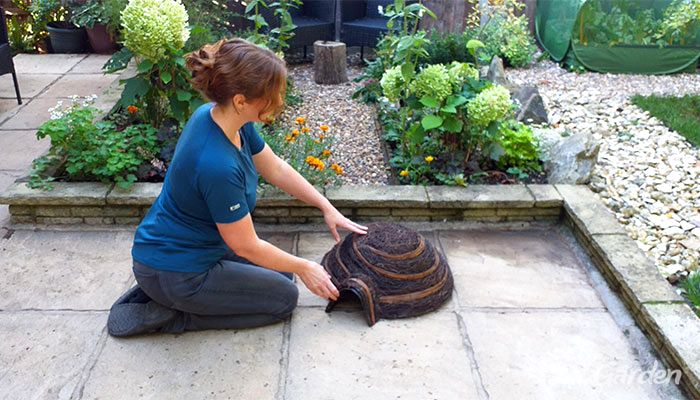
It has a porch area to deter predators, but there’s no flooring – this igloo is built to sit directly on the grass.
Because of the way it’s designed, I would say this is better as a feeding station than a hedgehog house. It certainly makes a great natural-looking cover for a bowl of meat-flavoured Go Cat.
The open base makes cleaning up spilt food and hog poo easy – you can just move the shelter around the garden to keep areas free from rot or messy build-up.
This little igloo is well built. The steel frame is surprisingly strong – I sat on it and it stayed in place. Honestly, I expected it to be weaker than that from the photos!
The felt-type plastic feels thick and the brushwood covering is well attached.
I actually already have one of these that I use as a hedgehog feeding station. Mine is 6 years old. Compare the two in the photo below – the old one (on the right) has lasted well although the plastic has disintegrated and water falls through now.
Six years is not bad though, bearing in mind it’s been out in all weathers.
It’s not the best hedgehog house in terms of safety. It’s too easy to tip over – a semi-determined badger could have this over in a minute or two and there’s no baffle to stop paws dragging out the residents.
The open floor means damp and cold will seep upwards and the steel framework will drip condensation down on the hedgehogs if they’re sleeping in there; their little fat bodies give out lots of heat.
That said – it is better than nothing. This igloo will protect hedgehogs from a strimmer, spade, or rake and it’ll stay drier than a compost heap or pile of hedgerow leaves.
Very easy. Because it doesn’t have a base just lift it up to clean beneath.
I’d keep this on a dry bit of the garden to stop mud and damp filtering up. Maybe on the patio or some bark.
A mixed bag with this one – it has some strong positives as well as negatives. Firstly, if budget is an issue, this will certainly do just fine. Ideally, I think it’s best as a feeding station instead of a permanent residence, but it’s still better than nothing in our cold, wet winters.
Did you find this review helpful?
Product Tester
In my mission to find the best hedgehog houses, I comprehensively evaluated several products. My testing process included the following criteria:
- Design and Build Quality: I scrutinised the construction of each hedgehog house, assessing the quality of the materials used, as well as their durability, and the overall design of each hedgehog house. Hedgehog houses made from durable, sturdy hardwood with a removable lid and built-in floor are by far the strongest design, so these got top marks. I looked for key features that enhanced the design and made it more effective – if it had features like raised feet, protection from predators, and rain resistance, it was rated higher.
- Hedgehog Safety: Ensuring the safety of our spiky friends was, of course, a priority. I carefully examined the entryways and tunnels, as these prevent potential predators like foxes, cats, and badgers – a ‘baffle’ entry with one or more 90° bends is the best at stopping predators, so these were given the highest rating. A lock on the lid is also a vital feature to protect hedgehogs, so this was given top marks!
- Ease of Cleaning: A removable lid makes it easier to clean the hedgehog house after the hibernation period, so a design where the lid could be easily removed was given a higher rating. I also checked how easy these hog houses were to move and deemed anything over 4 kg as hard to move.
- Size and Weight: Hedgehog houses need to be at least 40 cm in width and length to house a mother hog and her litter, and the entry hole needs to be approximately 13 cm. Any designs that didn’t take this into account were deemed unsuitable.
- Aesthetics: To be effective, a hedgehog house needs to blend into its surroundings. Otherwise, you’ll likely get no attention from hedgehogs or too much attention from predators. Hedgehog houses made from natural-coloured wood or stained to blend into the garden were considered the best, while those with unnatural colours were considered the worst.
- Value for Money: When assessing value for money, I considered each design’s performance, features, and price point, making sure to account for practicality and everyday use.
Compare Product Features
Use the dropdown to sort the table by the feature you want to see.
Riverside Woodcraft Hedgehog House
- 4.9
- Rectangular
- 5kg
- Wood, composite roof
- 52cm x 51cm x 20cm
- No
Wildlife World Hogilow Hedgehog Home
- 4.8
- Spiral
- 3.85kg
- FSC certified wood
- 50cm x 39cm x 23cm
- No
The Hutch Company Hedgehog House
- 4.6
- Rectangular
- 4.5kg
- Timber
- 46cm x 41cm x 28cm
- No
Clifford James Hedgehog House
- 3.8
- Rectangular
- 4.08kg
- Wood, composite roof
- 40cm x 40cm x 19cm
- Yes
Igloo Hedgehog House
- 3.3
- Round
- 2.38kg
- Wicker, steel frame
- 54cm x 21 cm x 46cm
- No
How to Choose The Best Hedgehog House
Hedgehog numbers are declining at a shocking rate in the UK. Unbelievably, we’ve lost a third of them since the millennium. The good news is your garden can provide a lifeline for these sweet little animals.
You can start helping hedgehogs right away by establishing a safe and welcoming environment in the garden in the following ways:
- Create a hole in your fence line/dig a tunnel beneath it
- Put out a shallow heavy bowl of water and some cat biscuits or hedgehog food to tempt them in
- Throw away slug pellets
- Pick up your netting
- Create an escape route from steep sided ponds
Check out The Ultimate Guide to Looking After Hedgehogs for more ideas.
Once you’ve prepared these steps, it’s time to get a hedgehog house. When hedgehogs realise your garden is safe, well-stocked and has a steady water supply, they’ll want to move in!
The following information will help you work out the best hedgehog house to buy, and how to prepare for your new garden guests:
Hedgehog House Design
Wooden Hedgehog Houses
If you want a wooden hedgehog house, go for real hardwood.
Plywood just won’t go the distance, and the last thing you want is rotting wood surrounding a nest or hibernating hog – rot makes hedgehogs vulnerable to predators and fungal infections.
If you buy a stained or varnished hog house, it will last longer; however, it may take a season for hogs to move in. They have sensitive noses and strong smells can deter them initially. Once the house has been weathered, hedgehogs will be more likely to use it.
Metal-Framed Hedgehog Houses
Metal framed hog houses can cause condensation, so wooden houses are usually recommended by wildlife charities, but there’s no escaping the fact that metal-framed houses are usually better value. If you do go for one, try to make sure it gets enough ventilation to dry out.
Additionally, it’s important to check metal-framed houses inside and out before use, in case there are any sharp edges.
Hedgehogs can get caught or cut by protruding pieces of metal, so it’s really important to keep the houses in good condition and check them regularly. If you spot a hedgehog in trouble, check this Ultimate Wildlife Rescue Guide for advice.
It’s also a good idea to peg down a metal-frame house as they don’t tend to weigh much and can be easily flipped over. An excitable dog, child, cat or fox could all be in danger of tipping over a hedgehog house.
Tent pegs can be used to secure a hedgehog house – push them through the frame and brushwood into the earth beneath.
Houses with Tunnels
If you are able to stretch to a slightly pricier version that has a tunnel and two internal sections, the hedgehogs will be safer from predators.
You want to avoid predators being able to stick their paw in to drag out bedding or even the hedgehog itself. Some of the best hedgehog houses feature a predator-proof tunnel; this is often a narrow tunnel with at least one 90° bend in it. These will stop predators from reaching their paws into the main room of the shelter.
Baby hedgehogs (known as hoglets – awh!) are especially vulnerable, so you should at least make a tunnel yourself if you choose a house without one – a few bricks will make all the difference.
READ NEXT: The UK’s Latest Hedgehog Population Decline Statistics
Buying a Hedgehog House vs a Feeding Station
Hedgehog houses can be used as either nests or protected feeding stations.
However, the houses shouldn’t be used as both. If you put food inside the home of your resident hedgehog, you risk attracting other hedgehogs (creating potential turf wars), predators and flies into their chambers. It will basically make nest invasions inevitable.
You can either buy two hedgehog houses, and use one for each purpose, or create your own feeding station by placing a patio slab on bricks. Placing hedgehog food outside in the open overnight will likely attract neighbourhood cats and foxes, but hedgehogs will get a look in on the food as well.
If you want to double check who or what is actually eating the food you put out, installing a wildlife camera can be reassuring; that way you can check that the hedgehogs are benefitting.
Encouraging Hedgehogs to Move in
Once you’ve got a hedgehog home, you’ll be wondering how to attract those hedgehogs.
Here are a few things you can do to get them coming to your garden:
- You will need hedgehog-sized garden access so that hogs can find your house. They can’t climb over fences, so a 15 x 15 cm hole in the fence will help them get in. Failing that, use a spade to dig beneath your fence to create a tunnel (this might need to be discussed with your neighbour first…!). If there’s no access, there will be zero hedgehogs.
- Ensure a clean, reliable water source is easily accessible. Wildlife will visit your garden if you leave out water. The trick is to make it clean and consistent. Hogs travel several kilometres a night and they get very thirsty. In hot weather many hedgehogs are taken to wildlife rescues with severe dehydration – imagine not having a drink for days in a heat wave. If you spot a hedgehog sunbathing take it straight to a vet or wildlife charity.
- After water comes food. Never give hedgehogs bread and milk no matter what your friends say. Hedgehogs are lactose intolerant and giving them products with lactose will cause diarrhoea. This can cause hedgehogs to die of dehydration. Bread won’t kill them, but it has no useful nutrients. The best food is dry or wet cat food in a meaty flavour or hedgehog food.
How to Position Your Hedgehog House
There are some tricks to siting a hedgehog house – they prefer certain areas over others.
Choose a sheltered spot on dry soil that doesn’t get waterlogged. Think about the winter months – does it get wet there? If so, find another location – damp will cause health problems for hibernating hedgehogs.
Also think about heat. A hedgehog house in direct boiling sun can kill a hedgehog inside. If you have any large hedges (evergreens are particularly good) that’s a good place to position a hedgehog house.
Hedgehogs like a bit of cover when they emerge, plus it helps maintain a consistent temperature within the shelter.
You should also turn the door so it faces away from prevailing winds. Hedgehogs won’t appreciate any 50 mph gusts blowing inside the shelter and creating a chill.
The final step is to make sure it’s not placed on a hedgehog footpath. Hedgehogs often frequent certain paths as they enter and leave your garden. Often they run along the fence line if that’s where they access your garden from. If this is the case, don’t put the hedgehog house there. It’s too busy to be attractive to potential residents. Hogs like secret sheltered places.
Tip: Don’t be tempted to bury the hedgehog house as this creates damp. Cover it with leaves if you want, and then keep watch from a distance.
When to Prepare Your Hedgehog House
Any time is a good time to put a hedgehog house out – right now is excellent, in fact!
Hedgehogs are active for most months of the year, even during hibernation they are often looking for water and food in warmer snaps. During these times it’s possible that the hedgehog will happen across your much more suitable accommodation and choose to move in.
Hedgehogs use houses in a number of ways:
1. Hibernation – Hedgehogs hibernate for several months because food is in short supply. Don’t worry – feeding them cat food won’t interrupt their natural hibernation – it’s the cold that triggers the instinct. Hibernating hogs will feel cold to the touch, breathe shallowly and appear dead. Don’t move any hog out of a house in winter because you assume it’s died – it’ll just be deeply asleep.
2. A day nest – don’t worry if your hog disappears for a few days, they have large territories and can’t always make it back in time, so they have several nests in the area. Dirty stop outs indeed! Something as simple as a dog walker crossing their path at 5 am can prevent them returning before sunrise.
3. Nests – Females can have several litters a year and hedgehog houses can make the perfect nursery. They usually give birth in June or July, and may have a second litter around September/October. Therefore, keeping a hedgehog house out keeps it as a viable option for any expecting mothers.
If you don’t want to have your hedgehog house out all year long, you can put it out in autumn to help potentially hibernating hedgehogs. They can start hibernating as early as November, and may stay hibernating until late March. This is all dependent on the weather as well as the hedgehog.
How to Prepare Your Hedgehog House
Hedgehogs are good at finding dry, warm bedding materials, and it’s not necessary to provide any for them. However, if you do decide to do some preparation for your hedgehog, you could use dust-free hay, leaves and dry moss to line the house.
Only half fill the house with these materials, leaving some near to the entrance as well. This will allow hedgehogs to ‘find’ and bring in their own bedding, which is part of their nesting process.
One thing that’s definitely worth doing, is clearing the garden of anything unsuitable that a hedgehog might try to use for bedding, such as plastic bags. They’re very resourceful animals, so it’s best not to leave anything lying around that might cause them harm.
Don’t put food, water or any type of chemical, including flea powder, in the house. Food and water may attract pests, whilst flea powder can be fatal to hedgehogs.
Remember to clean your hedgehog house too, once it’s vacant. Everything needs to be emptied out, as the natural bedding of leaves, plant material will rot down. Ticks also fall off and breed so the bedding, so that’s another reason to carefully clear the house out after each nesting season.
Wear gardening gloves and allow the house to be aired out for at least a day.
Hedgehog House FAQs
No, don’t put food inside a hedgehog house. Nests can be invaded by other hedgehogs and predators looking for food. Plus, old rotten food will attract flies. If you want to put food out for hedgehogs, create a feeding station for them that’s separate from their nest.
You can check inside a hedgehog house to see if a hedgehog has moved in, but don’t look too often. Checking too frequently may put perspective hedgehogs off. If/when you do have a resident, leave them alone and don’t look inside the house. They will move out if you disturb them, and a mother hedgehog will kill her babies if you touch them or she feels invaded.
If you want to see hedgehogs, keep an eye on the garden at dusk and dawn. Alternatively, an inexpensive night-time camera will help you to see hedgehogs, and other wildlife, in the garden.
Putting a hedgehog house in your accessible garden, near a clean regular water source, will make the world of difference to our struggling hedgehog population. They are endearing, and surprisingly useful for gardeners as they will eat slugs and snails.
Hedgehogs need all the help they can get, and your garden is one of the best places for a hedgehog house to keep the dwindling population alive for future generations.
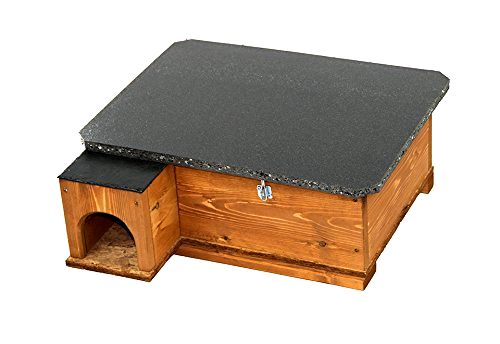
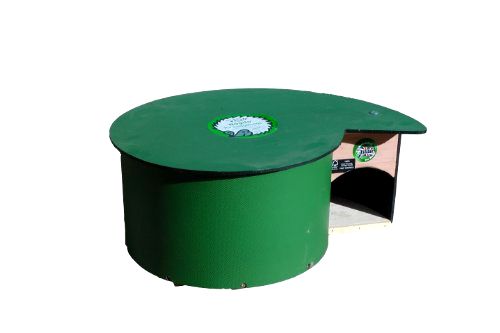
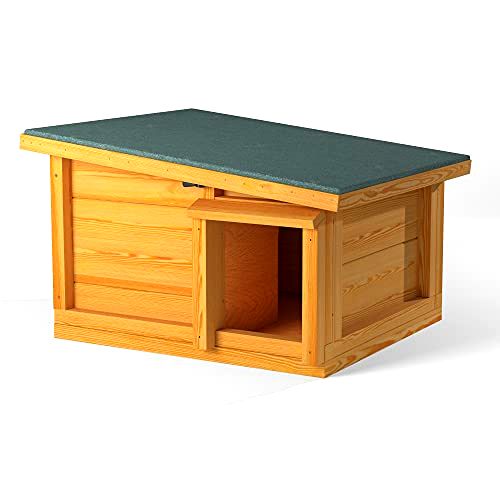
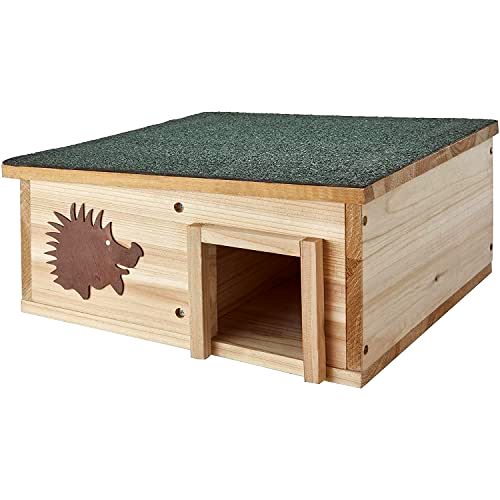
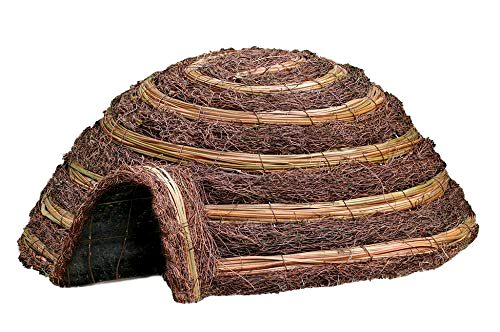
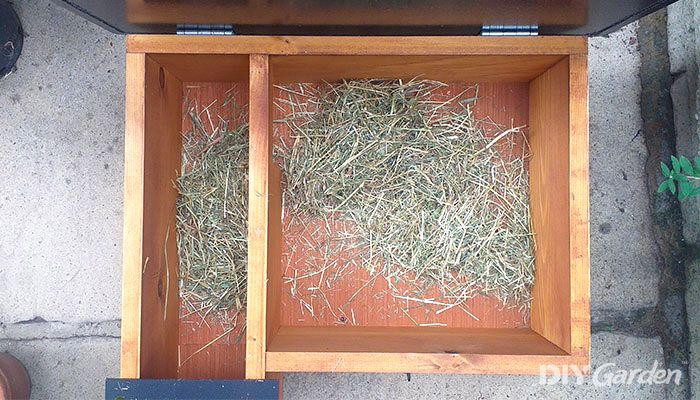
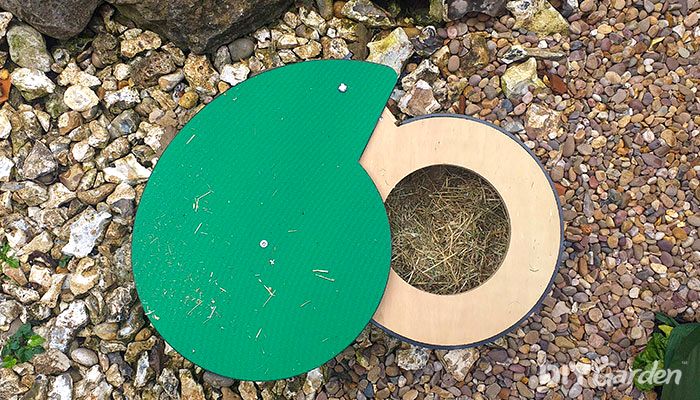
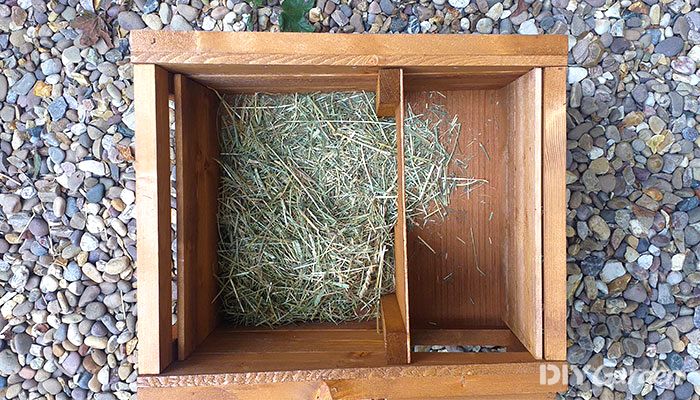
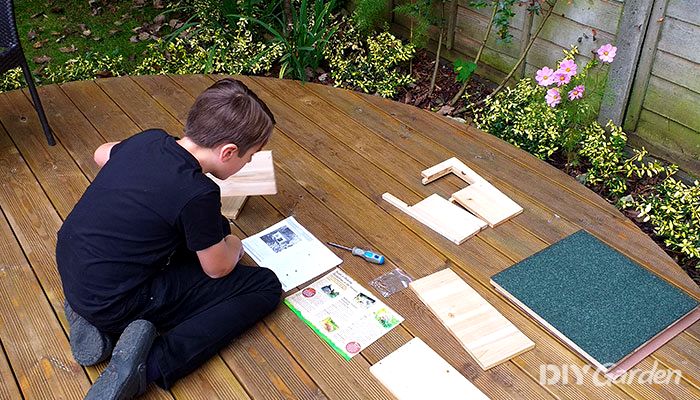
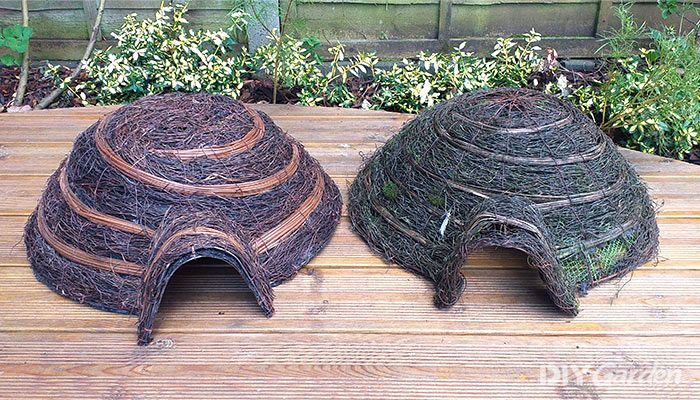

Share